Kalimantan: Sacred Trees and Sharman Rituals Experiencing the Jari Janang Kalalawah festival
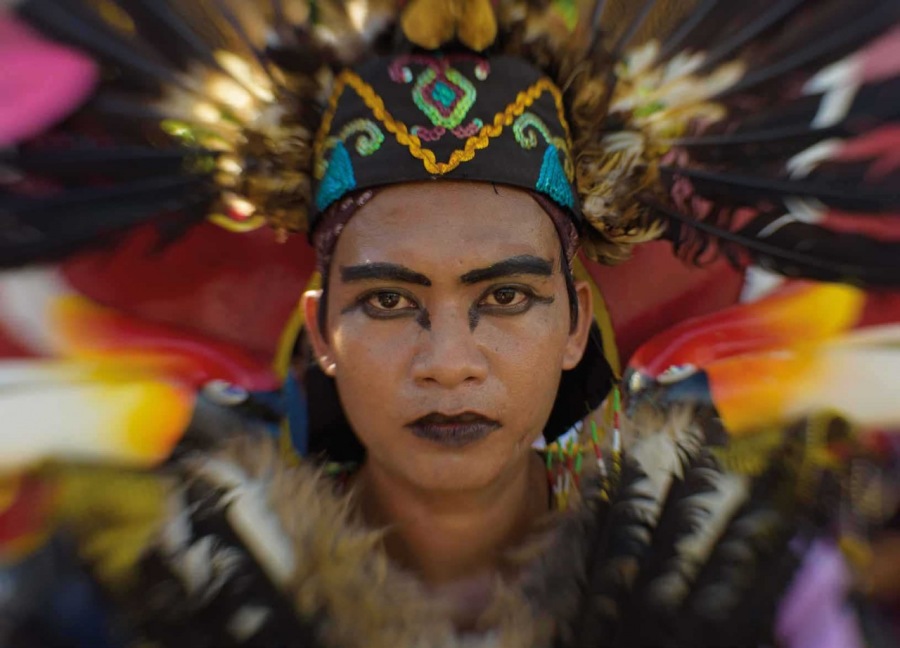
Before I entered the Dayak house, Ardiyansah performed a small welcome ceremony. Using his original Dayak Ma’anyan language he stated, “This blessing is to honour you as my guest. Leave all diseases and other things behind; leave all religion and any beliefs outside”. Splashing holy water on my head and smearing white paste on my brow, he then added, “As you enter this house, we are as one. You are now accepted as one of us. You are family”.
Author in Source Title
After each of my four traveling companions received a similar welcome, we were all invited to take our place on the tika (woven mat) in the lounge. A lovely natural conversation started to flow with Ardiyansah, a middle aged Dayak Ma’anyan man, while the other family members got busy in the kitchen. It had been a very long journey from Palangkaraya to Haringen Village, in East Barito, a region of Central Kalimantan. I really felt like I was in the heart of Borneo now, seven hours inland and not a foreigner in sight. We had stopped at a restaurant on the way and, when I placed my order for our group, the girls on the serving counter shrieked and ran away to the back of the kitchen. I love this kind of travel moment. Later, I found out that they had never seen foreigners before, let alone served them. The manager appeared after some time and asked us what we would like. She did not seem fazed at all by our appearance or my funny-sounding Jakarta twang Bahasa Indonesia. After about 15 minutes the young girls reappeared, looking sheepish. They still stayed at a safe-counter distance, and would not engage with us. Surely, we were not that scary.
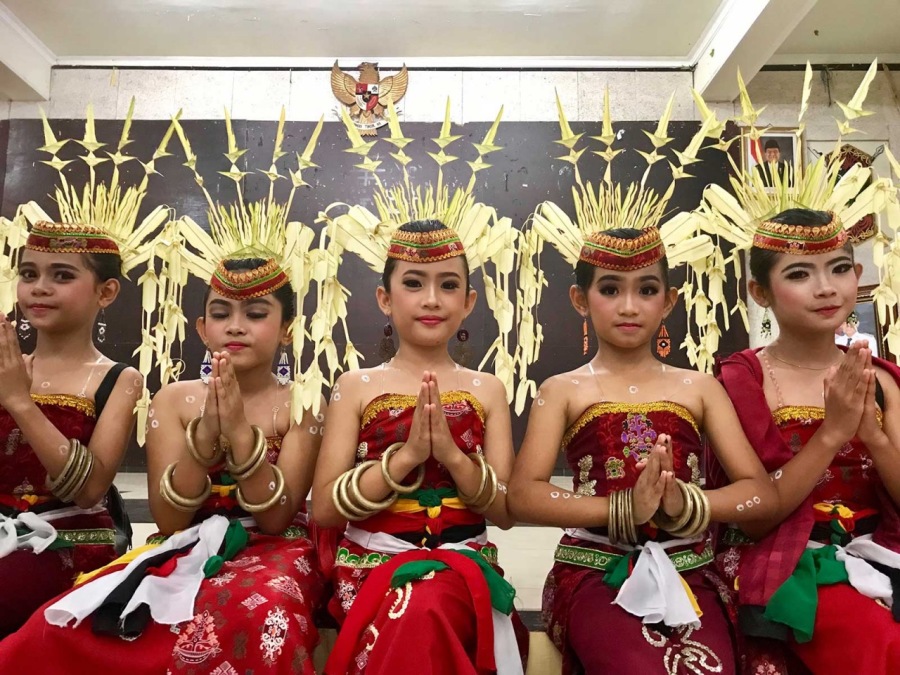
That was not the only extreme encounter. We stopped at a gigantic roundabout in another small town we passed through, about the only thing of note there. When we piled out of the car to stretch our legs, five foreigners, we soon heard screams of delight and a chorus of, “Selfie, selfie, mister”, which seemed to come out of nowhere. Soon there was a line of motorbikes with 2, 3 and 4 people to a bike, all waiting to talk to us. Although they all wanted selfies, no one had a camera. “On your phone. It’s very cool to get a selfie, and you are not from here. Yes, please, selfie-selfie.” Of course, we responded very enthusiastically and agreed to all the selfies. The locals also took advantage of the opportunity to practice their English with “real live foreigners”, as they referred to us. Once all the selfies were taken, they all took off in a big rush, still squealing with delight. A great travelling moment indeed and, as always when travelling in Indonesia, the encounters you have are so friendly and so delightful, one just wants to keep travelling. The more remote you go, the more enchanting these encounters seem to be.
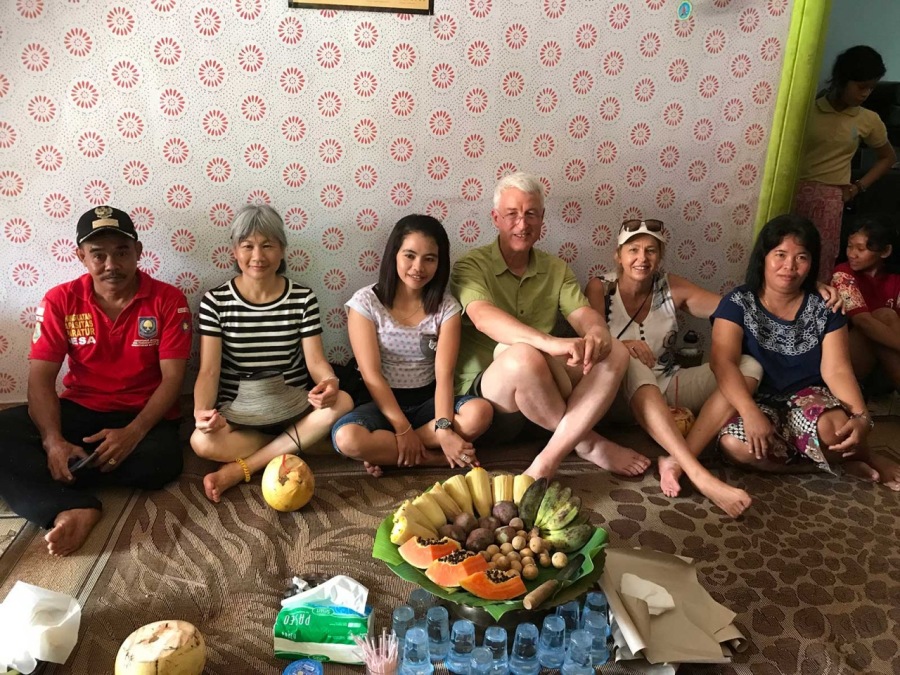
Our first evening at Ardiyansah’s house, in Haringen Village, was all about the food and getting to know the family. We were all really looking forward to enjoying some of the delicious Dayak food we had heard so much about. Different family members soon began laying an astounding array of Dayak dishes out in front of us on the tika. There was a selection of forest greens plus other colourful vegetables, tofu and tempe, chicken, and river fish. Somehow bat soup snuck in there. Yes, they had to sneak in a bat dish. “We call it batman soup”, Ardiyansah said, as he saw my skeptical look. Everyone laughed at that, and my courageous fellow travellers actually each took a bowl with a complete bat in it. I gave the bat delicacy a miss, but there were to be other opportunities. I saw some kind of bat dish every day, in the form of breakfast bat soup, seared bat and bat stew. A variety of edible grubs and bug dishes was also presented. Dayak food is an all-encompassing culinary experience and, as Ardiyansah explained, “We Dayaks eat everything”. Indeed, every day was a huge feast of different dishes, invariably including some items I simply did not recognise.
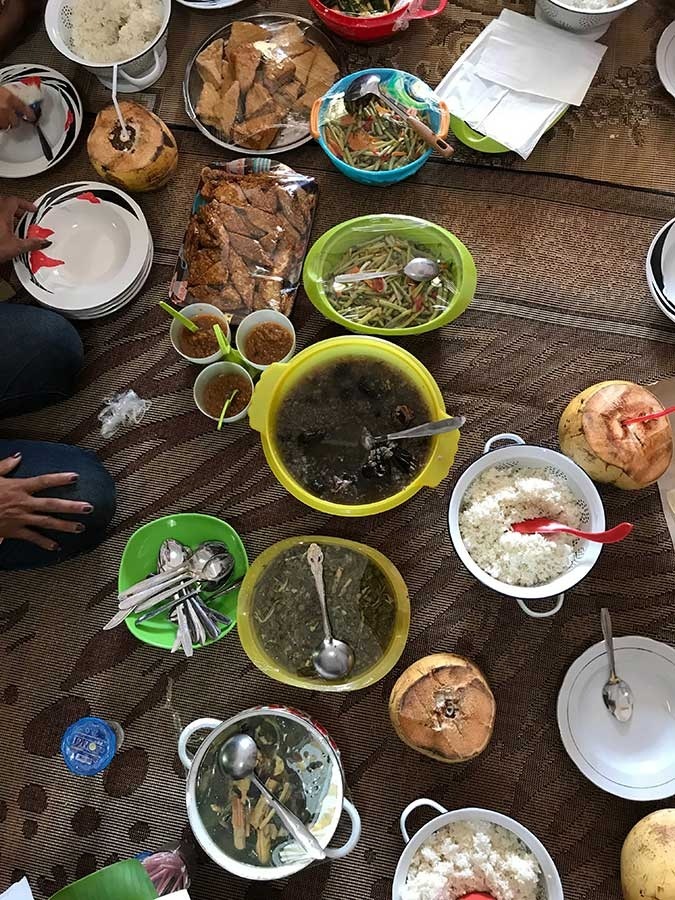
After dinner, we crawled under our mosquito nets and found the simple well-padded floor mattress very comfortable. We slept in one long line, Dayak style, waking early to join Yedi, for a walk in the nearby forest. A young man of 28, Yedi was already a shaman. He was the son of the owner of the house, also a shaman, but everyone recognised that Yedi already possessed greater powers than his father. He explained to us how he came to develop these powers. At the age of 10, Yedi received a message he was a chosen one when he had an unexplained illness as a child. While he was ill, the spirits kept returning to him, giving him more and more information. “Once I told people about this, there was a ritual at my house. I learned rites and ceremonies from a master shaman who spoke in an ancient language. I had to learn this language first. This language is only passed on orally, nothing is written.” He continued, “A shaman is a healer and a helper, like a doctor. Other people have powers to cast spells, but shaman do not have these powers”.
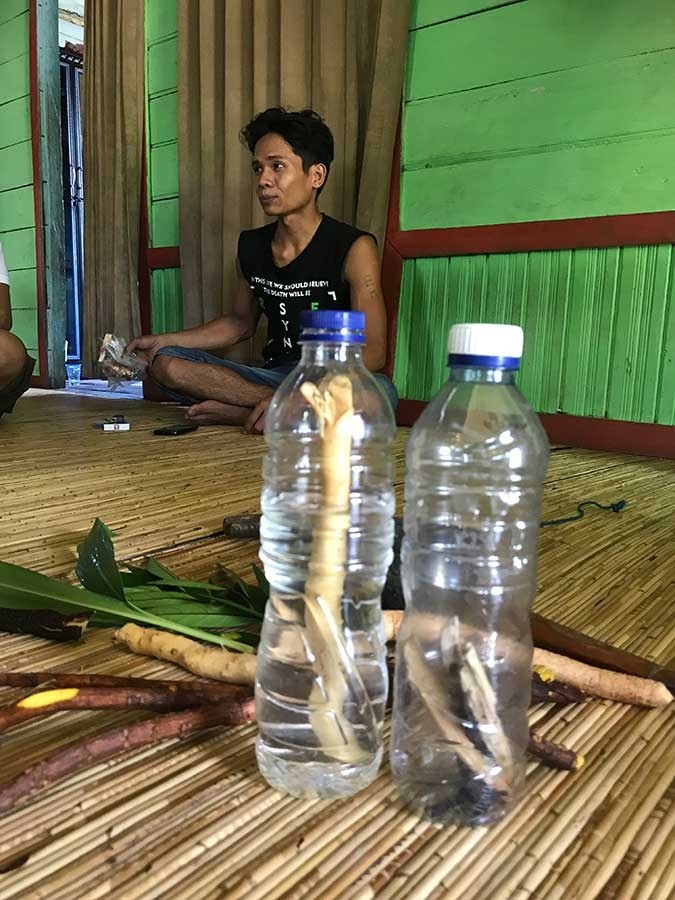
As we stood at the edge of the forest, Yedi said quietly, “I am ready now, let us go to the sacred trees”. So we followed him into the forest, walking single file. After a few minutes, we came to a stop and he explained, “I must bury a coin here at this sacred tree and give offerings before I take the root”. He was gathering medicinal plants and roots for a healing session later that day. As he pulled up the root, he added, “It’s very important that I pull up the root facing away from me”. Yedi also scraped some bark from the same tree and then said, “I will take some of these leaves too. This is known as Pasak Bumi and gives strength. I will make this into a tea”.
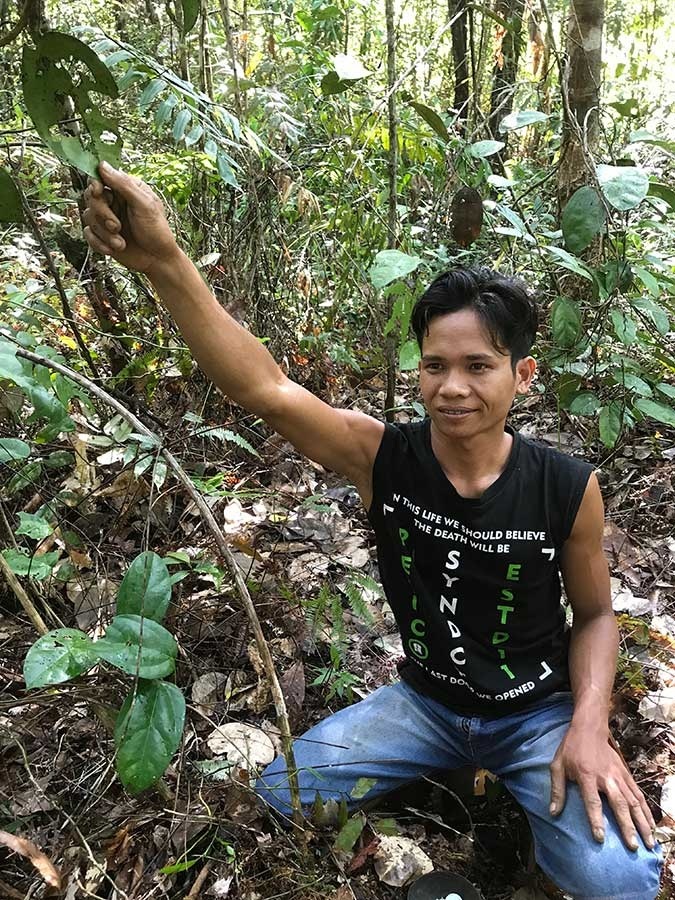
The young shaman then took us deeper into the forest to show us other sacred trees there. The next tree, a Sima Wuket tree, had a yellow root which helps with diabetes and hepatitis. Before Yedi took the root, he pounded the ground to “wake up the tree” and then buried a coin and some rice next to it. “This tree cannot be planted,“ he said, “It only holds power by growing naturally in the forest. Lucky for me, this one is near my house”. Each looked very old, and beautiful in its own way, and we paused before each tree while Yedi entoned a brief prayer. He then went on to show us other sacred trees, including the Rirung Tree, whose leaves are used in dance ceremonies, the Kamat Tree, and the Balik Angin Tree. Yedi told us, “There is one more very sacred tree, called Kayu Simali Mali, however, it is far away in the mountains”.
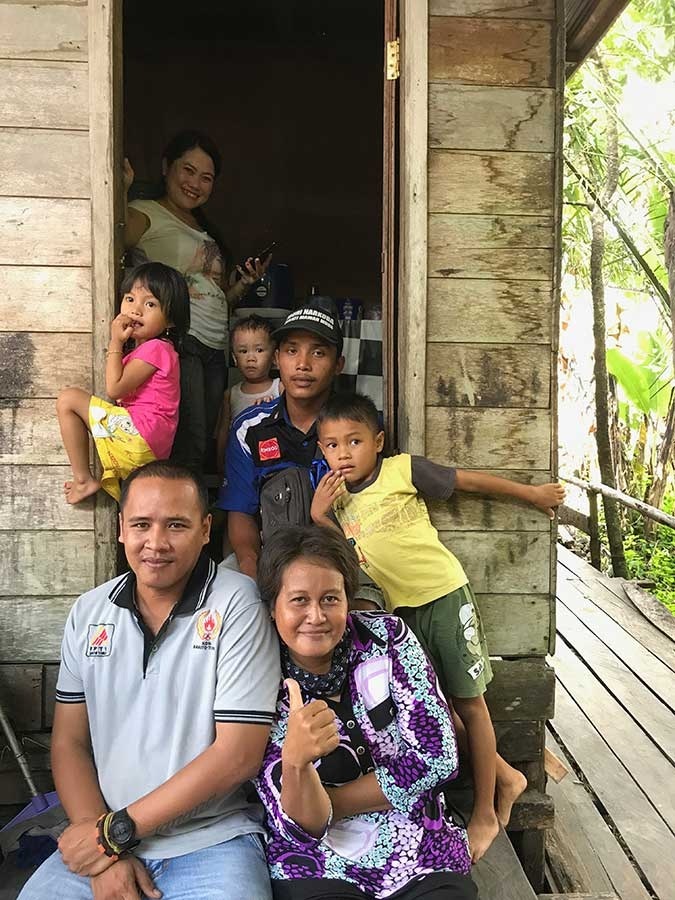
Along the way, Yedi showed us his bracelet, “This is important”, he stressed, “as when you are a shaman you know that there is danger that your spirit can be lost, because of the forces you are working with, so you must always have your bracelet with you. You need it to guide you”. After our forest walk, we said our farewells to our wise young shaman and headed home to get ready for our next adventure. This involved attending the opening parade of a local festival in the main town of Tamiang Layang, where 17 sub-tribes of Dayaks were gathering to dance, sing, play their traditional instruments and celebrate their culture. For me, the highlight of the Jari Janang Kalalawah festival came when the elders, shamans and shawomen gathered on the stage. They sat in a storytelling circle to share their knowledge, wisdom and life lessons passed down through the generations. Because we were foreign guests, we were invited up on the stage too, so we could listen more closely. For our benefit, each story was translated into English. We got to hear the essence of each extraordinary tale. No one seemed to mind the fact that this translation exercise doubled the time taken on the storytelling.

In all, we attended three days of this cultural festival, yet again as the only foreigners. Every day we had the most gracious hospitality bestowed on us. We immersed ourselves in the beautiful and rich Dayak culture, participating in spinning top and other traditional games, giving comments on the elaborate spreads of food from the different regions, watching the shield painting competition and celebrating with the different tribes. We made many new friends and got to know them better through their stories, dance and music. It really felt like we had touched the culture in a very authentic way.
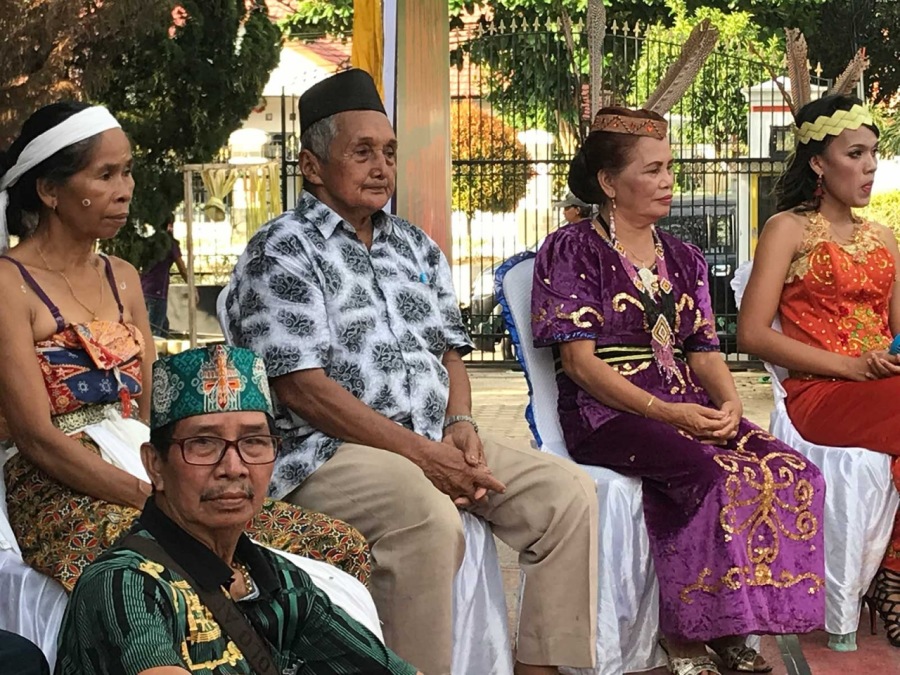
Stephanie is leading a trip to Haringen Village and Tamiang Layang, Central Kalimantan, April 26 – 2 May, which includes homestay accommodation with dinner bed and breakfast at the shaman’s house, attending the local Dayak festival (Jajaka Bracelet Dance Festival 2019), lunch with the family of the adat (traditional) leader, a visit to a black orchid forest and a traditional weaving village. You are welcome to join this unique (small group size) cultural adventure to meet the Dayak Ma’anyan. A very authentic journey of discovery. https://www.davidmetcalfphotography.com/tours/borneo-maanyan-culturaltour/
Story by Stephanie Brookes | Photo by David Metcalf
Stephanie Brookes is a travel writer and blogger with tales from Indonesia and beyond.
www.travelwriter.ws
http://www.facebook.com/stephtravelwriter
www.instagram.com/stephtravelwriter
David Metcalf runs photo workshops in Bali and cultural photography tours in Bali, Borneo, Vietnam, Odisha India and Myanmar.
www.davidmetcalfphotography.com
http://www.instagram.com/davidmetcalfphotography
http://www.youtube.com/user/DayakDave
Artikel dari Stephanie Brookes
Lihat blog
Sitting on a woven mat, I listened as a Dayak Simpang elder explained, “Our history and our story ar ...

Anniina Sandberg shares her experience of living in a Tanzanian Maasai family compound with the goat ...
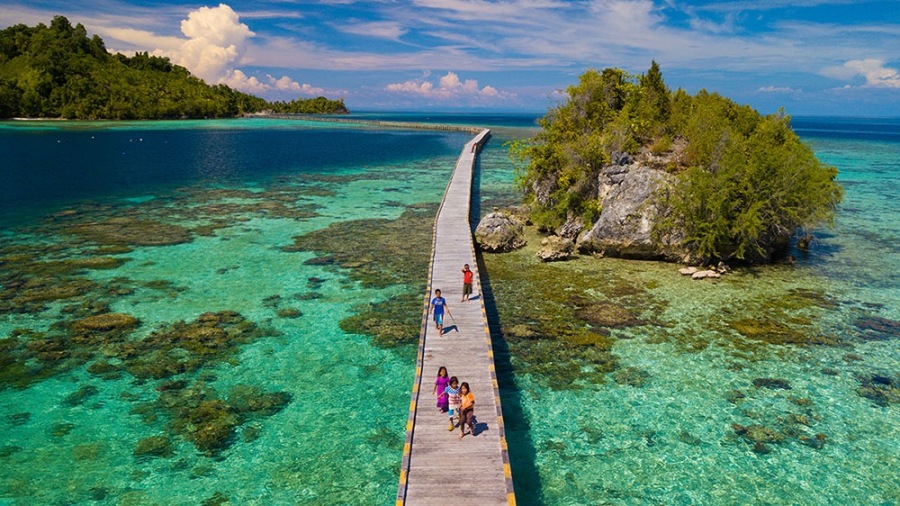
The Togean Islands form an archipelago of 56 islands strung across the Gulf of Tomini in Central Sul ...
Anda mungkin tertarik dengan pekerjaan ini
-

Microsoft 365 Specialist
Ditemukan di: beBee S2 ID - 2 hari yang lalu
RGF HR Agent Recruitment indonesia - jakarta, Indonesia Permanent- Proactively identify opportunities for process improvement, automation, and enhancement of Microsoft 365-Continuously develop solutions and collaborate closely with stakeholders to tailor solutions for business needs using Microsoft 365-Work with global teams to understand thei ...
-

Business Development Chemical
Ditemukan di: beBee S2 ID - 11 jam yang lalu
RGF HR Agent Recruitment indonesia - jakarta, Indonesia Permanent- Manage trading business under Inorganic and advanced material domain.- Leveraging the assigned business and expected to understand market structure, both customer's and supplier's strategy.- In a long term will be responsible to developing new business with leveraging the exist ...
-

QC Manager
Ditemukan di: beBee S2 ID - 3 hari yang lalu
RGF HR Agent Recruitment indonesia - jakarta, Indonesia Permanent・Management and QC Planning work・Implement the QA/QC management system at site・Coordinate with the customers representative on quality matters・Distribute relevant QA/QC documentation to site subcontractors・Reviewing quality management specifications and technical something docume ...
Komentar